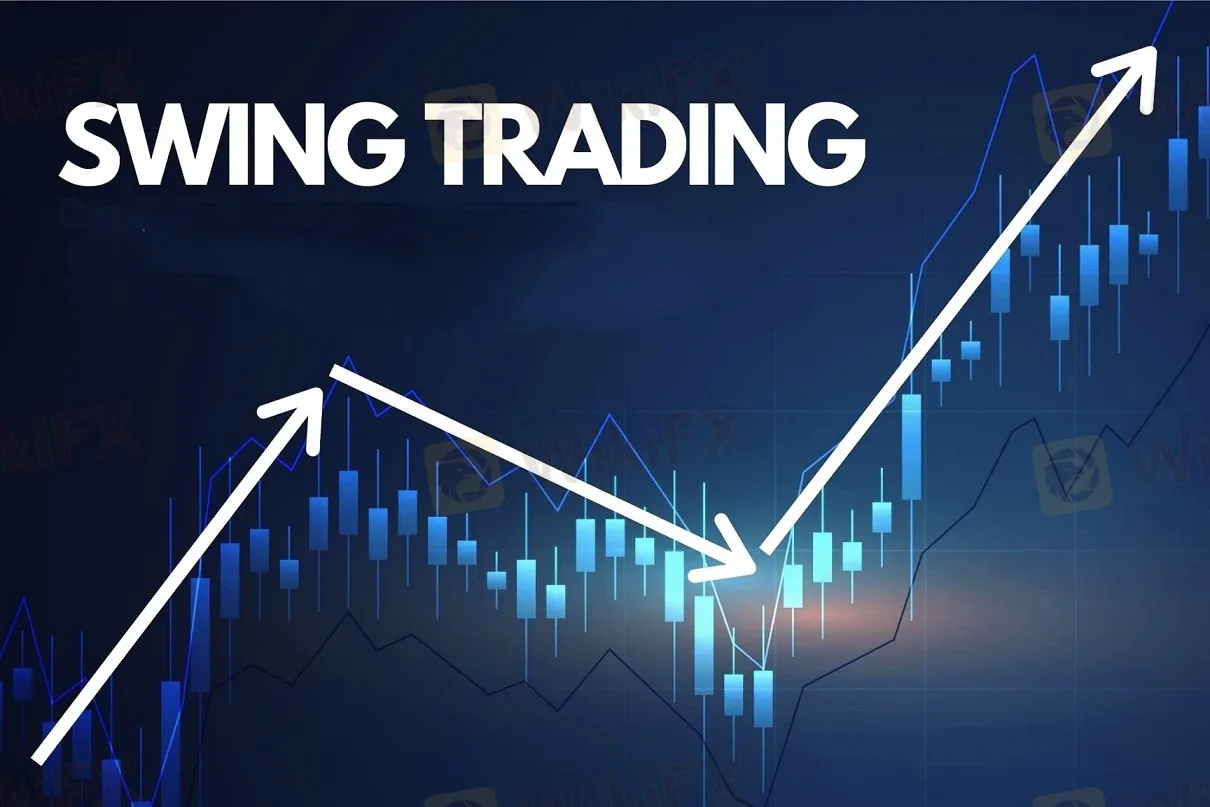简体中文
繁體中文
English
Pусский
日本語
ภาษาไทย
Tiếng Việt
Bahasa Indonesia
Español
हिन्दी
Filippiiniläinen
Français
Deutsch
Português
Türkçe
한국어
العربية
Swing Trading | How It Works | Pros and Cons
Abstract:Swing Trading is a mid-term trading strategy that aims to capture the short to medium-term fluctuations in asset prices within a trend.

In the rapidly changing financial markets, investors are constantly seeking flexible strategies to adapt to the market and achieve substantial returns. Swing trading, as a unique and popular trading strategy, is attracting the attention of an increasing number of investors. This article will delve into the fundamental principles of swing trading, key strategies, and essential elements for successfully implementing this strategy. Whether you are a beginner or an experienced trader, understanding the core concepts of swing trading will provide robust support for your success in the ever-evolving financial environment.
Definition
Swing trading is a short to medium-term trading strategy that aims to capture the mid-term fluctuations in asset prices within a trend. The basic idea is to trade between the low and high points of price fluctuations, capturing a significant portion of potential price movements. It's important to note that swing traders do not blindly chase after the entire upward movement of a phase (which is indeed unlikely), but rather aim to capture a part of the expected price trend and then move on to the next opportunity.
This strategy style falls between day trading and trend trading, with holding periods ranging from overnight to several weeks. Swing traders typically use technical analysis tools such as chart patterns, trendlines, and technical indicators to assist them in assessing market trends and potential entry and exit points. Compared to trend investors, swing traders focus more on short-term price fluctuations, while compared to day traders, they hold positions for a longer duration.
The advantage of this trading strategy is that it can avoid the noise in day trading and is relatively less affected by market fluctuations in long-term investments. Swing trading may be an attractive strategy for investors who wish to trade more frequently but are unwilling to take on the high risk associated with day trading.
How Swing Trading Works
Selecting Trading Instruments
Traders begin by choosing financial instruments such as stocks, forex, or futures. Liquidity and volatility are crucial factors in selecting assets. Ideal swing trading targets are assets with high liquidity and volatility, such as large-cap stocks.
Analyzing Long-Term Market Trends
Financial markets generally exhibit three main long-term trends: bearish, bullish, or neutral. Swing trading is most suitable for market conditions between bull and bear markets, as neutral markets involve two-way price fluctuations that are harder to predict. Swing traders use technical and fundamental analyses to assess short to medium-term directional movements.
Analyzing Short to Medium-Term Trends of Targeted Assets
Focusing on short to medium-term fluctuations, swing traders typically use short-term charts like daily or 4-hour charts. Utilizing indicators such as Relative Strength Index (RSI), Moving Average Convergence Divergence (MACD), Fibonacci retracement, volume, and trendlines, they identify potential trends, support and resistance levels, and other technical indicators for informed decision-making.
Setting Up a Trading Plan
Based on market analysis, traders develop a trading plan, which can be categorized into trend-following or trend-reversal strategies. The plan includes entry points, stop-loss points, and profit targets. Entry points are often chosen at price reversals or breakthroughs of support/resistance levels, while stop-loss and profit targets are critical for risk control and profit-taking.
Executing Trades
Once the trading plan is in place, traders execute trades, involving order placement, setting stop-loss and take-profit orders, etc. Disciplined execution is essential, adhering to the pre-established plan.
Monitoring Trades
While swing trading doesn't require constant monitoring, periodic trade checks are necessary. This includes daily chart reviews and adjustments to the trading plan when market conditions or new information arise.
Adjusting Trading Plans
If market conditions change or initial analyses deviate, traders may need to adjust their trading plans. This could involve modifying stop-loss and take-profit levels or even closing positions early.
Discipline and Risk Management
Swing traders must maintain discipline, avoiding emotional influences from the market. Strict adherence to risk management rules ensures that each trade's risk remains within acceptable limits.
Real-Time Learning and Optimization
Swing trading is a continuous learning and optimization process. Traders should review and analyze each trade's successes and failures, consistently improving their trading strategies.
The Pros and Cons
| Pros | Cons |
| Relatively independent of economic cycles, providing trading opportunities in various market conditions. | Short to medium-term market fluctuations may be influenced by a lot of noise and random changes, leading to potential false trading signals. |
| Combines technical and fundamental analysis to capture most market movements, maximizing short-term profit potential. | Requires a higher level of technical analysis proficiency and market insight. |
| Requires less trading time and has lower costs compared to day trading, without the need for constant monitoring. | Compared to day trading, swing trading faces overnight and weekend market risks. |
| More flexible than trend trading, offering quicker profit generation, higher efficiency, and more manageable risks. | Compared to trend trading, swing trading may miss long-term trends due to premature profit-taking. |
FAQs
What is a swing in the trading system?
A swing is an up or down movement that is big enough to bring a new price level. It is not a trend but rather a movement in a trend.
Is swing trading profitable?
Swing trading can be profitable, but success depends on market conditions, individual skills, risk management, and discipline. No trading strategy guarantees profits; successful swing trading requires a deep understanding of the market and effective risk management.
Is swing trading good for beginners?
Swing trading may be complex for beginners, requiring high levels of technical analysis, market insight, and risk management. It's recommended for beginners to master fundamental knowledge and choose more robust trading strategies.
What is the 1% rule in swing trading?
The 1% risk rule means that the risk per trade should not exceed 1% of the account capital. This doesn't imply investing only 1% of the capital; you can invest as much as possible. However, if the trade loss exceeds 1% of your total capital, it should be closed.
Bottom Line
In general, swing trading is a trading strategy aimed at capturing mid-term market fluctuations. This approach is relatively independent of economic cycles, allowing for trading opportunities in different market conditions. By combining technical and fundamental analysis, swing trading seeks to maximize short-term profit potential. Compared to day trading, it requires less trading time, has lower costs, and doesn't demand continuous monitoring. However, swing trading also presents challenges, including the potential for false signals due to market noise and the requirement for high-level technical analysis and market insight. Effective risk management and discipline are crucial for the success of swing trading.
Disclaimer:
The views in this article only represent the author's personal views, and do not constitute investment advice on this platform. This platform does not guarantee the accuracy, completeness and timeliness of the information in the article, and will not be liable for any loss caused by the use of or reliance on the information in the article.
Read more

How to Avoid Risks from Scam Brokers in Forex Investment?
In recent years, the forex market has become a popular choice for global investors due to its high liquidity and 24-hour trading advantages. However, according to the recently concluded WikiFX "3·15 Forex Rights Protection Day " event, we received over 6,000 pieces of evidence exposing rights violations within a short period. This reflects that, although the forex industry is becoming more regulated, fraudulent platforms continue to emerge, causing significant suffering for many victims.

Exposing Trading Academy Scams: How Aspiring Traders are at Risk
In the age of digital finance, the promise of financial freedom through trading has never been more alluring. Social media is flooded with advertisements for trading academies claiming to turn beginners into expert traders in weeks, offering ‘guaranteed’ profits and ‘exclusive’ strategies. However, behind the glossy marketing lies a sinister reality as many of these so-called academies are nothing more than elaborate scams designed to exploit unsuspecting traders.

The Rise of Algorithmic Trading in Forex Markets: Opportunities and Risks
Over the past decade, the integration of technology into financial markets has revolutionized forex trading. Algorithmic trading, driven by complex mathematical models and real-time data, has become a cornerstone of modern trading strategies. This article explores the transformative impact of algorithmic trading on forex markets, as well as the opportunities and risks it presents.

Forex BackTesting: Pros and Cons | Best Free Backtesting Software to Explore
Imagine you're driving from New York City to Philadelphia and want to know if your route is optimal, then you take two steps: Firstly, you gather the traffic records in the past five years, including traffic patterns, historic weather conditions, and holiday congestion records. Second, you run simulations of your proposed road to see if it is most efficient and fuel-saving before an actual trip.
WikiFX Broker
Latest News
How to Avoid Risks from Scam Brokers in Forex Investment
Beware: Forex Investment Fraud Targeting Low Income Earners
Central Bank Policies,Forex Markets and Gold Prices
These 24 Crypto Scams Are Accelerating the Theft of Your Assets
Beware of Fake 'Educational Foundations' Targeting Crypto Investors, Warns North Dakota Regulator
49 Foreigners Arrested in Illegal POGO Raid in Pasay City
We Asked Grok About Illegal FX Brokers—Here’s What It Revealed
Exposing Trading Academy Scams: How Aspiring Traders are at Risk
Online Investment Scams on the Rise: How Two Victims Lost Over RM100K
Vanished Savings: How One Woman Lost RM412,443 to an Online Scam
Currency Calculator






